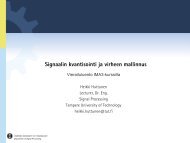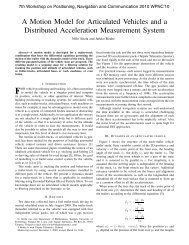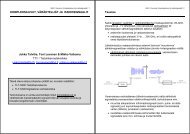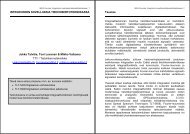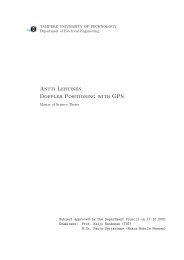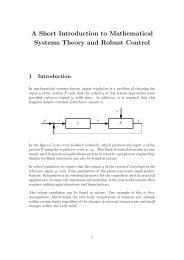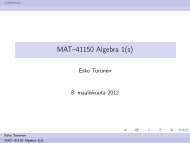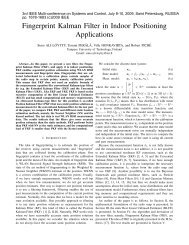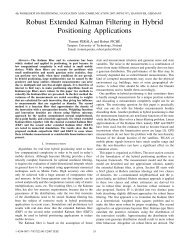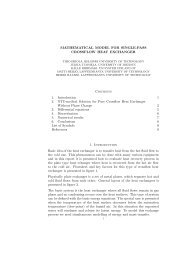GPS position can be computed without navigation data
GPS position can be computed without navigation data
GPS position can be computed without navigation data
You also want an ePaper? Increase the reach of your titles
YUMPU automatically turns print PDFs into web optimized ePapers that Google loves.
Proceedings of the ION <strong>GPS</strong> 2002, pages 2741-2744.<br />
<strong>GPS</strong> Position Can Be Computed<br />
<strong>without</strong> the Navigation Data<br />
BIOGRAPHY<br />
Niilo Sirola is a M.Sc. student at Tampere University of<br />
Technology majoring in technical mathematics and<br />
software design. He has <strong>be</strong>en researching assisted <strong>GPS</strong><br />
<strong>position</strong>ing algorithms since 2000.<br />
Jari Syrjärinne received his M.Sc. degree in 1996 and<br />
Doctor of Technology degree in 2001 from Tampere<br />
University of Technology, Finland. Since 1999, he has<br />
<strong>be</strong>en working for Nokia Mobile Phones where he also<br />
finished his doctoral thesis about modern techniques for<br />
personal <strong>position</strong>ing. His current research topics include<br />
cellular <strong>position</strong>ing, sensor fusion, and A<strong>GPS</strong>.<br />
ABSTRACT<br />
This paper presents an algorithm for computing a <strong>GPS</strong><br />
receiver's <strong>position</strong> and the current time from C/A-code<br />
phase measurements to at least six satellites and a set of<br />
valid satellite ephemerides. Reference <strong>position</strong> and<br />
reference time are not necessary. The process uses a cost<br />
function having numerous local minima in addition to the<br />
global minimum. An exhaustive search over the 5dimensional<br />
time-<strong>position</strong>-bias search space will reliably<br />
find the global minimizer, and thus solve the approximate<br />
<strong>position</strong> and time. Introducing a reference time within one<br />
minute from the true time resulted in worst-case<br />
computation time of a few seconds. If the current pseudorange<br />
correction parameters are available, the accuracy of<br />
this method is comparable to that of the conventional<br />
pseudo-range methods. As a conclusion, an accurate <strong>GPS</strong><br />
<strong>position</strong> <strong>can</strong> <strong>be</strong> solved in a reasonable time even <strong>without</strong><br />
the <strong>navigation</strong> <strong>data</strong> or precise system time.<br />
INTRODUCTION<br />
The method presented in this paper is intended for <strong>GPS</strong><br />
<strong>position</strong>ing in weak signal situations where the satellite<br />
signals are so noisy that C/A codes <strong>can</strong> <strong>be</strong> tracked but the<br />
<strong>navigation</strong> messages are <strong>be</strong>yond recognition [1,2,3]. The<br />
ephemeris and pseudo-range correction parameters could<br />
<strong>be</strong> already in the receiver's memory, or they could <strong>be</strong><br />
acquired via e.g. cellular network along with a delayed<br />
reference time [1]. A local <strong>position</strong>ing algorithm for this<br />
Niilo Sirola, Tampere University of Technology, Tampere, Finland<br />
Jari Syrjärinne, Research and Technology Access, Nokia Mobile Phones, Finland<br />
situation that requires initial time and <strong>position</strong><br />
approximations has already <strong>be</strong>en presented in [4]. This<br />
paper descri<strong>be</strong>s a global extension to the local algorithm.<br />
BACKGROUND: THE LOCAL ALGORITHM<br />
Use the following symbols:<br />
t, r, b system time, 3D user <strong>position</strong> and user clock<br />
bias to <strong>be</strong> solved,<br />
φi<br />
εi<br />
C/A code phase measurement to ith satellite,<br />
approximate ranging error compensation,<br />
si (t) <strong>position</strong> of ith satellite at system time instant t,<br />
and<br />
τi<br />
approximate time-of-travel from ith satellite to<br />
user.<br />
The range fit to the ith satellite is defined by<br />
( )<br />
(1) q ( t, , b) frac φ ε b ( t τ )<br />
r = + + − s − −r<br />
i Λ i i i i<br />
where Λ≈ 300 km is the length of the C/A code<br />
sequence and the lambda-fraction operator is defined by<br />
(2) frac round x<br />
Λ x x−Λ<br />
.<br />
Λ<br />
Note that the user clock bias b <strong>can</strong> <strong>be</strong> restricted <strong>be</strong>tween<br />
1 − Λ and 2<br />
1 Λ since the fraction operator eliminates<br />
2<br />
integer multiples of Λ.<br />
( )<br />
⎡t⎤ ⎡q1x⎤ Denoting =<br />
⎢ ⎥<br />
⎢ ⎥<br />
x<br />
⎢<br />
r<br />
⎥<br />
and q( x)<br />
= ⎢ ⎥,<br />
we <strong>can</strong> write the<br />
⎢⎣b⎥⎦ ⎢<br />
⎣qn( x)<br />
⎥<br />
⎦<br />
sum of squares cost function<br />
(3) ( ) ( ) 2<br />
1<br />
f x = q x ,<br />
2<br />
which has a minimum at the true <strong>position</strong> ( T, , B)<br />
R .<br />
When n > 5 and the satellite geometry is non-pathological,
i.e. both satellite <strong>position</strong>s and velocities are non-coplanar,<br />
this minimum is the unique global minimum.<br />
Figure 1 shows an example of the cost function projected<br />
into two dimensions. There are various local minima in<br />
addition to the global minimum at the true <strong>position</strong>. If any<br />
gradient-based minimization method is initiated far<br />
enough from the global minimum, the search will stray<br />
into one of the local minima and not <strong>be</strong> able to find the<br />
true <strong>position</strong>.<br />
Figure 1: Two-dimensional slice of the cost function<br />
An initial point ( t0, 0, b0)<br />
global minimum ( T, , B)<br />
(4)<br />
r lies "close enough" to the<br />
R at least when<br />
κ T − t + R− r + B− b < Λ ,<br />
0 0 0<br />
1<br />
2<br />
where κ ≈ 710 m/s (maximum Doppler velocity) [4]. If<br />
this condition is satisfied, then the true <strong>position</strong> <strong>can</strong><br />
always <strong>be</strong> reached with just a couple of Gauss-Newton<br />
steps given by<br />
(5)<br />
T<br />
−1<br />
T<br />
xk+ 1 = xk −⎡∇q( xk) ∇q( xk) ⎤ ∇q(<br />
xk) q( xk<br />
⎣ ⎦<br />
)<br />
.<br />
GLOBAL ALGORITHM<br />
The local algorithm finds the correct solution given an<br />
initial point inside the "attraction basin" of the true<br />
solution. Next, we construct a global extension of the local<br />
method. The purpose of the global phase is to launch the<br />
local search with different starting points, and identify<br />
whether the resulting point is the global minimum or not.<br />
Fortunately, it is easy to detect when the search is going to<br />
fail, <strong>be</strong>cause the cost function is smooth and convex near<br />
the true solution. Most often, when started outside the<br />
attraction basin, the Gauss-Newton search takes so large a<br />
step that it would take the solution outside the region<br />
defined by (4). This is a clear indication of failed search.<br />
Also, the cost function value at the true <strong>position</strong> is<br />
considerably smaller than in any of the local minima.<br />
The search space<br />
The search space is five-dimensional, consisting of the<br />
system time a.k.a. <strong>GPS</strong> time, 3D <strong>position</strong>, and user clock<br />
bias. Under the assumption that the satellite ephemeris is<br />
valid, the system time is bound within two or three hours<br />
from the time-of-ephemeris, depending on whether the<br />
ephemeris is fitted for four or six hours. The user is<br />
assumed to <strong>be</strong> on the Earth surface or within couple of<br />
kilometers above or <strong>be</strong>low it, and the clock bias range<br />
1<br />
equivalent is by definition inside ± Λ. 2<br />
The brute-force approach is to span a grid over the search<br />
space such that at least one grid point necessarily satisfies<br />
the condition (4). If the system time is divided into<br />
intervals of two minutes, it suffices to divide the surface<br />
of the Earth into squares 100km across and the bias into<br />
intervals of 100km. This results in over 15 million distinct<br />
points to inspect. We <strong>can</strong> start the local search from every<br />
point and pick the resulting minimum with the smallest<br />
cost function value as the solution.<br />
The computational load of the brute-force approach is<br />
roughly equal to 15 million point <strong>position</strong> fixes. This is<br />
hardly practical. There are two ways to accelerate the<br />
search: reduce the num<strong>be</strong>r of grid points, and speed up the<br />
local search.<br />
Satellite visibility<br />
Instead of searching the whole Earth, we <strong>can</strong> restrict the<br />
user <strong>position</strong> to the area where all the measured satellites<br />
are above the horizon. Figure 2 demonstrates the visibility<br />
region of three satellites. The point r on the Earth surface<br />
<strong>be</strong>longs to the visibility area roughly when<br />
(6)<br />
T 2<br />
i ≥rEarth ∀i<br />
s r .<br />
1234567<br />
1234567<br />
1234567<br />
1234567<br />
1234567<br />
1234567<br />
1234567<br />
1234567<br />
1234567<br />
1234567<br />
1234567<br />
Figure 2: Satellite visibility region<br />
In case of eight satellites, the visibility region has an<br />
average area of 30 million square kilometers, which is
about 5% of the total Earth surface area. The more<br />
satellites are available, the smaller the visibility area, and<br />
thus less grid points to search. This suggests that all the<br />
available satellites should <strong>be</strong> used in this visibility search<br />
phase, even if some of those have such a low signal-tonoise<br />
ratio that they should not <strong>be</strong> used in the actual<br />
<strong>position</strong> solution.<br />
In practice, it is most efficient to divide the four-hour<br />
system time span into intervals of about 2 minutes and<br />
search the whole visibility region of one interval <strong>be</strong>fore<br />
moving to the next one.<br />
Gradual local search<br />
Secondly, we try to reduce the time spent inspecting one<br />
point. Instead of executing the full local search at every<br />
point, we try some heuristic methods to spot and eliminate<br />
the "bad" points as fast as possible, leaving us hopefully<br />
with just one point that satisfies all the conditions and is<br />
the true solution.<br />
First, given time and <strong>position</strong>, we check if there is a bias<br />
value such that all range fits qi have absolute value smaller<br />
than some pre-defined constant qthres. The denser the<br />
search grid is, the lower value <strong>can</strong> <strong>be</strong> set for qthres.<br />
However, if qthres is too small the search might miss the<br />
true <strong>position</strong>.<br />
If a good initial bias was found, we launch a rough local<br />
search from the obtained point. This phase uses roughly<br />
approximated cost function and takes just a few iteration<br />
steps to check whether the search converges or not. The<br />
search is terminated if the iteration step is too large and<br />
would take the solution outside of the assumed attraction<br />
basin or too far from the Earth surface.<br />
Rough search initiated inside the attraction basin of the<br />
true solution will produce a <strong>position</strong> estimate with an<br />
accuracy of a few kilometers. However, a few additional<br />
local minima are usually found.<br />
In the final phase, the full-precision local search is<br />
launched starting from the coarse minimum. Some of the<br />
searches fail to converge, but most of them produce a<br />
local minimizer of the cost function. Fortunately, the cost<br />
function value at the global minimum is considerably<br />
smaller than in any of the local minima. If f is <strong>be</strong>low a<br />
threshold value calculated from the chi-square<br />
distribution, we have found the true <strong>position</strong>, and stop the<br />
search.<br />
Reference <strong>position</strong> or time<br />
It is also possible to use any kind of additional <strong>position</strong> or<br />
time information to further restrict the search space, e.g.<br />
cell coverage if cellular base station coordinated are<br />
available. Usual cell ranges are within few tens of<br />
kilometers in rural area and few kilometers in more urban<br />
areas.<br />
Wireless assistance <strong>can</strong> also include a coarse <strong>position</strong><br />
estimate, which naturally <strong>can</strong> also <strong>be</strong> used. In this case,<br />
the <strong>position</strong> search space reduces to just one point and<br />
only the correct time has to <strong>be</strong> found. Conversely, roughly<br />
known system time restricts the system time search to just<br />
one two-minute interval.<br />
TESTING<br />
The proposed methods were implemented in Matlab for<br />
testing and simulations. Actual ephemeris from the<br />
morning of May 16 th 2001 was used, but all the<br />
measurements were simulated.<br />
Figure 3 depicts a user in Tampere, Finland using<br />
satellites 1, 6, 10, 17, 24, and 30 on May 16 th 2001 at 6:12<br />
UTC. The figure shows the edge of the visibility region of<br />
the satellites at the time and the points for which the initial<br />
bias was found as red circles. The rough local search from<br />
these points produced six solution <strong>can</strong>didates, marked<br />
with blue crosses. Only one point, the actual user <strong>position</strong>,<br />
satisfied the cost function threshold after the refined local<br />
search, and it is marked in the figure as a blue asterisk.<br />
Figure 3: Visibility region, <strong>position</strong> <strong>can</strong>didates and<br />
true <strong>position</strong> (Background: Day Earth Texture Map<br />
©2002 The Living Earth, Inc.)<br />
We also studied the time Matlab spent computing a single<br />
<strong>position</strong> fix. While this does not predict the actual DSP<br />
load, it will give some overall insight of the complexity of<br />
the problem. Figure 4 shows statistics about the time-perfix<br />
as a function of satellites used. The more satellites are<br />
available, the smaller the satellite visibility region gets<br />
and thus the num<strong>be</strong>r of possible solutions to check<br />
decreases. The <strong>position</strong> search is terminated as soon as a<br />
satisfactory solution is found, which could with good luck<br />
happen with very first points checked, or with bad luck<br />
the last one. Thus, the total computation times vary from a<br />
fraction of a second up to minutes. Overall, it seems that<br />
at least eight satellites are required to fix the <strong>position</strong> in<br />
reasonable time. The maximum observed <strong>position</strong>ing time<br />
for seven satellites was 2.6 minutes, and for six satellites<br />
over 7 minutes.
Time / s<br />
120<br />
100<br />
80<br />
60<br />
40<br />
20<br />
Computation time<br />
95%<br />
max<br />
mean<br />
0<br />
6 7 8 9 10 11<br />
Num<strong>be</strong>r of SV’s<br />
Figure 4: Computation time using just satellite<br />
visibility region<br />
Finally, we also experimented with initial time known<br />
within one minute. This is a very modest requirement for<br />
timing assistance, and even the receiver's internal clock<br />
should <strong>be</strong> able to meet this requirement. With this<br />
information, the computation time is reduced by two<br />
orders of magnitude (Figure 5).<br />
Time / s<br />
2<br />
1.5<br />
1<br />
0.5<br />
95%<br />
mean<br />
Computation time<br />
max<br />
0<br />
6 7 8 9 10 11<br />
Num<strong>be</strong>r of SV’s<br />
Figure 5: Computation time assuming reference time<br />
within one minute<br />
CONCLUSIONS<br />
As a conclusion, an accurate <strong>GPS</strong> <strong>position</strong> <strong>can</strong> <strong>be</strong> solved<br />
<strong>without</strong> the <strong>navigation</strong> <strong>data</strong> and <strong>without</strong> accurate time<br />
assistance from the network, sometimes even in a<br />
reasonable time. The receiver still needs the ephemeris<br />
parameters and the pseudo-range correction parameters,<br />
but they are valid for hours after reception and thus easy<br />
to deliver to the receiver in time. In fact, there already are<br />
cellular standards for US CDMA, US TDMA, and<br />
European GMS and UMTS systems for network<br />
assistance messages containing these information<br />
elements [5,6]. The presented method makes it possible to<br />
solve <strong>GPS</strong> <strong>position</strong> with rather modest assistance.<br />
In comparison to the conventional <strong>GPS</strong> and A<strong>GPS</strong><br />
(Assisted <strong>GPS</strong>) or WAG (Wireless Assisted <strong>GPS</strong>)<br />
solutions, this method has several potential advantages.<br />
Most importantly, <strong>GPS</strong> <strong>navigation</strong> <strong>be</strong>comes possible in<br />
some bad signal conditions, even with time assistance<br />
signifi<strong>can</strong>tly worse than the 1.5 or 3 seconds required by<br />
the earlier solutions [2, 3]. Additionally, while the<br />
conventional receiver must listen to at least a few seconds<br />
of the <strong>navigation</strong> message in order to acquire the system<br />
time, this algorithm <strong>can</strong> start calculating as soon as the<br />
assistance <strong>data</strong> is present.<br />
The drawback is, evidently, the increased requirement of<br />
computational power at least in the case where even the<br />
coarse reference time is unavailable.<br />
When compared to the conventional least squares<br />
pseudorange <strong>position</strong>ing method, range fitting produces<br />
somewhat less accurate <strong>position</strong> fixes due to the system<br />
time and thus satellite <strong>position</strong>s <strong>be</strong>ing solved inaccurately<br />
[4]. However, the accuracy difference is marginal and<br />
negligible in practice since it will <strong>be</strong> buried in multipath<br />
etc. especially in weak signal situations.<br />
Another downside of the presented method is that exact<br />
<strong>GPS</strong> time <strong>can</strong>not <strong>be</strong> solved thus not making it possible to<br />
acquire accurate time from <strong>GPS</strong>. On the other hand, exact<br />
time is not needed in <strong>navigation</strong> applications or in<br />
emergency call <strong>position</strong>ing in which only good coverage<br />
and rapid time-to-fix will make a difference.<br />
ACKNOWLEDGEMENTS<br />
The authors would like to thank Professor Ro<strong>be</strong>rt Piché<br />
for his constructive comments and advice.<br />
REFERENCES<br />
[1] Syrjärinne, J. Possibilities for <strong>GPS</strong> time recovery<br />
with GSM network assistance. Proceedings of ION<br />
<strong>GPS</strong> 2000.<br />
[2] Enge, P., Fan, R. & Tiwari, A. <strong>GPS</strong> reference<br />
network's new role: providing continuity and<br />
coverage. <strong>GPS</strong> World, July 2001.<br />
[3] Bryant, R., Dougan, S. & Glennon, E. <strong>GPS</strong> receiver<br />
algorithms & system for weak signal operation.<br />
Proceedings of ION <strong>GPS</strong> 2001.<br />
[4] Sirola, N. & Syrjärinne, P. <strong>GPS</strong> <strong>position</strong>ing <strong>without</strong><br />
<strong>navigation</strong> <strong>data</strong>. Proceedings of ENC-GNSS2002,<br />
27-30 May 2002, Copenhagen.<br />
[5] TDMA Third generation wireless system assisted<br />
mobile <strong>position</strong>ing through satellite teleservice. SP-<br />
4027-740 Draft text. June 5, 2000.<br />
[6] ETSI GSM LCS TS 101 527 V7.2.0 (2000-04).<br />
Mobile station (MS) - serving mobile location centre<br />
(SLMLC) radio resource LCSD protocol (RRLP).<br />
GSM 04.31 version 7.2.0.



